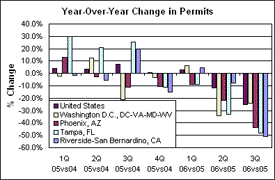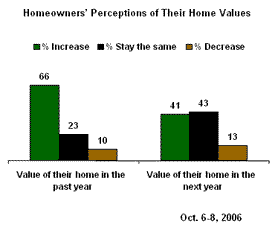The National Association of Realtors held their [annual convention in New Orleans](http://www.realtor.org/convention.nsf/) this year and with that came a series of press releases, most notable was their [housing forecast about future prices and sales volume [CNN/Money]](http://money.cnn.com/2006/11/10/real_estate/realtors_slump_not_bust/index.htm?postversion=2006111017).
* Existing Home Sales – will fall 8.6% total in 2006 but will only fall 0.6% in 2007.
* New Home Sales – will fall 16.8% in 2006 and another 8.7% in 2007.
* Existing Home Median Sales Price – will increase 1.9% this year and 1.7% next year.
* New Home Median Sales Price – will drop 1.1% this year and increase 1.3% next year.
* Inventories will continue to expand.

NAR attributes the positive forecast due to low mortgage rates, stable employment, low inflation and more competitive (lower) pricing by sellers. This contradicts the projections of most analysts, which are not as optimistic, suggesting that its going to [take three years to absorb the excess inventory [MW]](http://www.marketwatch.com/news/story/story.aspx?siteid=mktw&guid={35A757AB-9FED-4D0E-9EFA-A73E84A788A3}). [Building permits, for example, are down more than 20% [JB]](http://www.realestateconsulting.com/usanalysis/usanalysis200611.html).
I am not sure how their chief economist David Lereah forecasts these trends but they don’t make sense, or at least when using the reasons he provides. NAR actually forecasts slightly higher mortgage rates and rising inventory next year. What is thje catalyst that reverses the currenbt trends. In other words, what will change to cause these forecasts to occur?
I understand these are national numbers and local markets will behave relatively independent of each other, but thats not what is being presented here. Its a rehash of the theme brought up in the [NAR recent ad campaign [SFGate]](http://www.sfgate.com/cgi-bin/article.cgi?f=/g/a/2006/11/10/carollloyd.DTL).
According to [a recent Gallup poll, homeowners are still optimistic about the value of their home [Free access on 11/13/06 only – main details below](http://www.galluppoll.com/content/?ci=25420).

* 66% say the value of their home increased in the past year, while 23% say it stayed the same and 10% say it decreased.
* 41% of Americans expect the value of their home to increase during the next year; 43% of homeowners say the value will stay the same and 13% say it will decrease.
* 27% say they have seriously considered selling their home in the past year. Of those who have considered selling their home, just 16% say they acted on this option. The majority of those who have thought about selling their home, 52%, say they have delayed putting their home on the market, while 29% say they have decided against selling their home altogether.
* 71% of men and 61% of women think the value of their home increased this year.
* The optimisic outlook for next year was relatively similar across all income groups. 39&% of people with incomes of less than $30K, 45% with incomes of $30K to $74.9K and 41% with incomes of $75k or more thought the value of their homes would increase next year.
* The housing outlook changed by region: 35% in the east, 42% in the midwest, 47% in the south and 39% in the west think that property values will increase next year.
I suppose if you keep saying something long enough, it becomes reality. After all, value is influenced by perception. Public relations 101. For all the criticism of NAR and its distortion of certain housing realities, its efforts have largely proved to be effective. Whether or not this is a good stimulus for the housing market is another matter.
3 Comments
Comments are closed.


This was NAR’s forcast for 2006: “The national median existing-home price for all housing types is forecast to rise 5.1 percent to $219,700 this year. The median new-home price is expected to increase 6.0 percent this year to $245,200 (NAR). – National Association of Realtors”
It appears that Americans are going to die en masse of starvation in the near future, as a result of having absolutely zero money for food.
The only question is the cause. Having housing costs and related debt absorb 100 percent of their income. Having health care costs absorb 100 percent of their income. Having college costs for their kids absorb 100 percent of their income. Or a combination of the three.
It may be hard to conceive, but it is at least possible that at some point things will have gone too far and we will not all die after all.
But once you imagine that, it is also possible to imagine that things ALREADY HAVE gone too far.
I wonder how many people think the value of their home increases based on the mis-guided perception that because their tax assessments go up, the value of their home must go up as well. Those are pretty high percentages of people who think the value of their home has increased – 70% of men and 60% of women.